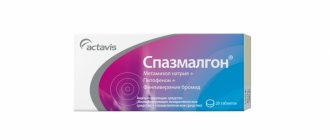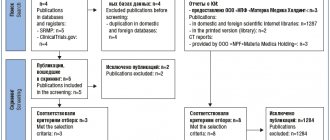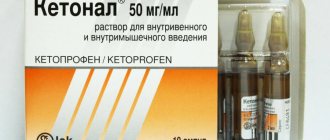Features of the drug
The main active ingredient in the medicine is methylprednisolone. Manufacturers offer metypred in the form:
- Lyophilisate. It is a white powder that may have a slight yellowish tint. It is packaged in 0.25 g bottles; in addition to the bottle, the kit includes an ampoule with a solvent. A solution is prepared from the drug for intramuscular or intravenous administration.
- Tablets. They may contain 4 or 16 mg of active substance. They are distinguished by their round shape, with a beveled edge on one side. Metipred 16 tablets are engraved “ORN 346”.
Indications for use of the drug Metipred
Conditions requiring systemic therapy with GCS are inflammatory and systemic rheumatic, autoimmune diseases, allergic conditions, anaphylactic shock, asthma and other lung diseases, as well as in order to reduce intracranial pressure (for example, with cerebral edema due to neoplasms), transplant rejection; some dermatological, hematological, hepatic, neurological (eg multiple sclerosis, myasthenia gravis), renal and gastrointestinal diseases (eg ulcerative colitis, Crohn's disease). Methylprednisolone is also used as an antiemetic in chemotherapy and as a component of regimens for the treatment of leukemia, lymphoma and malignant myeloma.
Prescription of the drug and contraindications
The drug metypred, the instructions for use confirm this, is used for various diseases in complex treatment. The list of indications is large, so only the attending physician should make a decision on drug therapy. Understanding what metypred is prescribed for, you should be aware that it also has contraindications. To eliminate negative reactions, they must be taken into account.
For short-term use, the only contraindication is hypersensitivity to the active substance and other components of the drug. This means that you need to carefully study the composition of the medicine before using it. Mitypred is not used for treatment when diagnosing tuberculosis. The drug is contraindicated for various infectious diseases: bacterial, fungal or viral.
Metypred should not be prescribed for treatment during pregnancy, as there is a risk of fetal death. It is recommended to use the medicine with caution when breastfeeding. Children are treated with the drug only if there are absolute indications under the strict supervision of a doctor.
Metypred should be used with extreme caution if you have the following diseases:
- Gastrointestinal tract.
- Of cardio-vascular system.
- Endocrine system.
- Kidney.
It is necessary to monitor the patient if treatment with metipred is carried out against the background of a diagnosis of hypoalbuminemia or conditions that can provoke its development. Careful monitoring of the patient's condition is necessary in case of glaucoma, mental disorders, osteoporosis and confirmation of parasitic infections.
Metipred, instructions for use, focuses on this, and has other contraindications. The doctor must take them into account when prescribing the drug.
Metypred
— Since complications of methylprednisolone therapy depend on the dose and duration of treatment, in each specific case, based on an analysis of the “benefit/risk” ratio, a decision is made on the need for GCS therapy, and the duration of treatment and frequency of administration are determined.
· The minimum effective dose of the drug should be used to ensure a sufficient therapeutic effect; if necessary, the dose should be reduced gradually.
— During GCS therapy, the development of various mental disorders is possible: from euphoria, insomnia, mood instability, personality changes and severe depression to acute psychotic manifestations. In addition, existing emotional instability or a tendency to psychotic reactions may increase.
- Potentially severe mental disorders may occur with the use of methylprednisolone. Symptoms usually appear within a few days to weeks after starting therapy. Most reactions disappear either after reducing the dose or after discontinuation of the drug. Despite this, specific treatment may be required. Psychiatric disturbances have been reported in association with discontinuation of methylprednisolone therapy; the frequency of these effects is not known.
— Patients and/or their relatives should be warned that if changes occur in the patient’s psychological status (especially with the development of depression and suicidal attempts), it is necessary to seek medical help. Patients or their relatives should also be warned about the possibility of developing mental disorders during or immediately after reducing the dose of the drug or completely stopping it.
- For patients who may be exposed to stress during GCS therapy, an increase in the dose of the drug is indicated before, during and after a stressful situation.
— Although controlled clinical studies have shown that methylprednisolone is effective in accelerating the recovery process during exacerbation of multiple sclerosis, it has not been established that methylprednisolone affects the outcome and pathogenesis of this disease. Studies have also shown that sufficiently high doses of methylprednisolone must be administered to achieve a significant effect.
— There are reports of the development of epidural lipomatosis in patients receiving methylprednisolone. Usually with long-term therapy at high doses.
- In patients receiving immunosuppressive doses of methylprednisolone, live or live attenuated vaccines are contraindicated, but killed or inactivated vaccines can be given, although the response to such vaccines may be reduced. Patients receiving treatment with methylprednisolone in doses that do not have an immunosuppressive effect may be immunized according to appropriate indications.
— During GCS therapy, some infections may occur in an erased form, in addition, new infections may develop. When using methylprednisolone, it is possible to reduce resistance to infections, and also reduce the body's ability to localize the infectious process. The development of infections caused by various pathogenic organisms, such as viruses, bacteria, fungi, protozoa or helminths, which are localized in various systems of the human body, may be associated with the use of methylprednisolone, both as monotherapy and in combination with other immunosuppressants affecting cellular immunity, humoral immunity or neutrophil function. These infections can be mild, but in some cases they can be severe and even fatal. Moreover, the higher doses of methylprednisolone are used, the higher the likelihood of developing infectious complications.
- The use of methylprednisolone in active tuberculosis should be limited to cases of fulminant disseminated tuberculosis, when GCS are used to treat the disease in combination with appropriate anti-tuberculosis chemotherapy. If the drug is prescribed to patients with latent tuberculosis or positive tuberculin tests, then treatment should be carried out under strict medical supervision, since activation of the process is possible. During long-term treatment with methylprednisolone, such patients should receive appropriate prophylactic treatment.
· The drug should be used with caution in case of eye damage caused by the herpes simplex virus, due to possible perforation of the cornea.
- GCS, including methylprednisolone, can lead to an increase in blood glucose concentrations, worsen the course of existing diabetes mellitus and, with long-term therapy, can lead to a predisposition to diabetes mellitus.
- Long-term use of methylprednisolone can lead to the occurrence of posterior subcapsular cataracts, glaucoma with possible damage to the optic nerve and provoke the addition of a secondary ocular fungal or viral infection.
· Methylprednisolone therapy can lead to the development of central serous chorioretinopathy, which in turn can lead to retinal detachment.
— Children receiving long-term therapy with methylprednisolone are at increased risk of developing intracranial hypertension.
- The use of high doses of methylprednisolone can lead to the development of pancreatitis in children.
- Allergic reactions (for example, angioedema) may develop. When using methylprednisolone, precautions should be taken, especially in patients with a history of allergic reactions to drugs.
- Medium and large doses of hydrocortisone or cortisone may cause increased blood pressure, sodium and water retention, and increased potassium excretion. These effects are less likely to occur with the use of synthetic corticosteroids (including methylprednisolone), except when used in high doses. It is necessary to limit the consumption of table salt with food and prescribe potassium supplements. All corticosteroids increase calcium excretion.
— Systemic corticosteroids, including methylprednisolone, are not indicated and should not be used for the treatment of traumatic brain injury. An increase in mortality was found at 2 weeks or 6 months after head injury in patients treated with methylprednisolone sodium succinate. There was no direct association with the administration of methylprednisolone sodium succinate.
— Osteoporosis is a common and, at the same time, rarely diagnosed adverse reaction that develops with long-term use of high doses of methylprednisolone.
- Children receiving the drug for a long time daily, several times a day, may experience growth retardation, so this dosage regimen should be used only for absolute indications. The use of alternating therapy usually avoids or minimizes this adverse reaction. When methylprednisolone is used in children, patients should be closely monitored for normal growth and development.
— Manifestations of secondary adrenal insufficiency that develop during GCS therapy can be minimized by gradually reducing the dose. This type of relative deficiency may persist for several months after the end of treatment, so methylprednisolone should be reintroduced during this period in any stressful situations.
Since the secretion of mineralocorticosteroids may be impaired, electrolytes and/or mineralocorticosteroids should be administered simultaneously.
— There is a more pronounced effect of methylprednisolone in patients with hypothyroidism and cirrhosis of the liver.
— Patients receiving drugs that suppress the immune system are more susceptible to infections than healthy people. For example, chickenpox and measles may be more severe and even fatal in unimmunized children or in adults receiving methylprednisolone.
— There is no consensus on the likelihood of developing peptic ulcers during methylprednisolone therapy. Methylprednisolone therapy may mask the symptoms of a peptic ulcer, which may result in perforation or bleeding without significant pain. GCS therapy may mask symptoms of peritonitis, as well as other signs and symptoms associated with gastrointestinal dysfunction, such as perforation, obstruction and pancreatitis. When used simultaneously with NSAIDs, the risk of gastrointestinal ulcers increases.
- The use of methylprednisolone in high doses can lead to the development of acute pancreatitis.
— There are reports of the development of reversible liver damage, which is relieved by discontinuation of therapy. In this regard, appropriate monitoring should be carried out.
- Undesirable reactions of methylprednisolone from the cardiovascular system, such as dyslipidemia, increased blood pressure, can provoke new reactions in predisposed patients in the case of high doses of methylprednisolone and long-term treatment. In this regard, methylprednisolone should be used with caution in patients predisposed to cardiovascular diseases and special attention should be paid to additional monitoring of the state of the cardiovascular system.
- Cases of thrombosis, including venous thromboembolism, have been reported with the use of GCS. Therefore, GCS should be used with caution in patients with current thromboembolic complications or who are predisposed to developing these complications.
- Methylprednisolone should be prescribed with caution for ulcerative colitis, if there is a threat of perforation of the walls of the gastrointestinal tract, the development of an abscess or other purulent infection, as well as for diverticulitis, in the presence of fresh intestinal anastomoses, with active or latent peptic ulcers, renal failure, arterial hypertension, osteoporosis, myasthenia gravis.
— Cases (including fatalities) of the development of crises have been reported in patients suffering from pheochromocytoma receiving systemic therapy with corticosteroids, including methylprednisolone. In patients with suspected or confirmed pheochromocytoma. Methylprednisolone should only be used after a careful benefit/risk assessment.”
— There have been cases of the development of Kaposi's sarcoma in patients receiving GCS therapy (after discontinuation of GCS, clinical remission may occur).
— The effectiveness of methylprednisolone in septic shock is questionable. The results of a systematic review of the use of the drug in short courses at high doses do not support its use in this regimen. However, it is assumed that the use of methylprednisolone in long courses (5-11 days) in low doses may reduce mortality.
- When using methylprednisolone in therapeutic doses for a long period, suppression of the hypothalamic-pituitary-adrenal system (secondary adrenal insufficiency) may develop. The degree and duration of adrenal insufficiency is individual for each patient and depends on the dose, frequency of use, time of administration and duration of therapy. The severity of this adverse reaction can be reduced by using the drug every other day or by gradually reducing the dose (see section “Dosage and Administration”).
- In addition, the development of acute adrenal insufficiency, leading to death, is possible with abrupt withdrawal of methylprednisolone.
- Caution must be exercised in patients with systemic scleroderma due to the fact that an increased incidence of acute scleroderma nephropathy has been observed when taking GCS, including methylprednisolone.
- Since methylprednisolone may enhance the clinical manifestations of Cushing's syndrome, the use of methylprednisolone should be avoided in patients with Cushing's disease.
— Acute myopathy most often develops with the use of high doses of methylprednisolone in patients with impaired neuromuscular transmission (for example, with myasthenia gravis), or in patients simultaneously receiving n-anticholinergics, such as peripheral muscle relaxants (for example, pancuronium bromide). This acute myopathy is generalized and can affect the muscles of the eyes and respiratory system, leading to the development of tetraparesis.
Possible increase in creatine kinase activity. However, improvement or recovery after discontinuation of methylprednisolone may occur only after many weeks or even several years.
- Withdrawal syndrome, apparently not related to adrenal insufficiency, can also occur due to abrupt withdrawal of methylprednisolone.
This syndrome includes symptoms such as anorexia, nausea, vomiting, lethargy, headache, fever, joint pain, skin peeling, myalgia, weight loss and/or decreased blood pressure. It is assumed that these symptoms occur due to sharp fluctuations in the concentration of methylprednisolone in the blood plasma, and not due to a decrease in the concentration of methylprednisolone in the blood plasma.
— The carcinogenic and mutagenic effects of the drug, as well as its adverse effects on reproductive functions, have not been established.
Treatment: recommended dosage
The dosage of the drug and the duration of treatment are determined individually. The tablets should be taken during or after meals. Take the medicine with a small amount of liquid.
The drug can be prescribed in an initial dosage of 4 mg - 48 mg per day. Such doses are used for various diseases that are mild. High doses (200-1000 mg/day) are prescribed for the following pathologies:
- Multiple sclerosis.
- Brain edema.
For organ transplantation, the dosage is calculated based on the patient’s body weight: 7 mg/kg/day. But if it is not possible to achieve the desired result after a certain time, then stop taking the drug and prescribe another type of therapy. For the treatment of children, if indicated, the dose of the drug is also calculated taking into account body weight.
The lyophilisate solution can be administered by intramuscular injection or intravenous infusion. The procedure involves slow injection. Moreover, if additional treatment is carried out in life-threatening cases, mitipred is administered intravenously over 30 minutes in an amount of 0.03 g/kg body weight every 6-8 hours. The procedures are repeated for no more than a day and a half.
After long-term therapy with the drug, you should not suddenly abandon the drug; the daily dose should be reduced gradually. Otherwise, a withdrawal effect may occur. This condition is characterized by depressive mood and aggression, increased fatigue and drowsiness.
Pharmacological properties of the drug Metipred
The effect of methylprednisolone (6-L-methylcortisone), like other corticosteroids, is realized through interaction with steroid receptors in the cytoplasm of the cell. The steroid-receptor complex is transported into the cell nucleus, binds to DNA and changes gene transcription for most proteins. GCS inhibit the synthesis of numerous proteins, various enzymes that cause joint destruction (in rheumatoid arthritis), as well as cytokines that play an important role in immune and inflammatory reactions. They induce the synthesis of lipocortin, a key protein in the neuroendocrine interaction of GCS, which leads to a decrease in the inflammatory and immune response. GCS, including methylprednisolone, suppress or prevent the development of tissue response to many thermal, mechanical, chemical, infectious and immunological agents. Thus, glucocorticoids act symptomatically, reducing the manifestations of the disease without affecting the cause. The anti-inflammatory effect of methylprednisolone is at least 5 times greater than that of hydrocortisone. The endocrine effects of methylprednisolone include suppression of ACTH secretion, inhibition of endogenous cortisol production, and, with long-term use, partial atrophy of the adrenal cortex. It affects the metabolism of calcium, vitamin D, carbohydrate, protein and lipid metabolism, therefore, with long-term use of GCS, an increase in blood glucose levels, a decrease in bone density, the phenomenon of muscle atrophy and dyslipidemia are possible. GCS also help increase blood pressure, modulate behavior and mood. Methylprednisolone has virtually no mineralocorticoid activity. With intramuscular administration of methylprednisolone, the maximum concentration in the blood serum is reached after 2 hours, the half-life is 2-3 hours. About 77% of methylprednisolone is bound to plasma proteins, the connection with transcortin is insignificant. Volume of distribution - 1–1.5 l/kg. Methylprednisolone is metabolized to inactive metabolites. The specific CYP enzymes responsible for its conversion are not known. The average clearance is 6.5 ml/kg/min. The duration of the anti-inflammatory effect is 18–36 hours. About 5% of methylprednisolone is excreted from the body in the urine.
Side effects of the drug Metypred
from the digestive tract: dyspepsia, increased appetite, peptic ulcers with perforation and bleeding, esophageal ulcer, esophageal candidiasis, pancreatitis, perforation of the gallbladder. From the musculoskeletal system: proximal myopathy, osteoporosis, tendon rupture, muscle weakness. Disturbances of water and electrolyte balance: sodium and water retention in the body, hypertension (arterial hypertension), hypokalemic alkalosis, hypokalemia, chronic heart failure. Skin: burning and pain at the injection site, slower regeneration, skin atrophy, acne. From the endocrine system and metabolism: suppression of the hypothalamic-pituitary-adrenal axis, growth retardation, menstrual irregularities, amenorrhea, Cushingoid face, hirsutism, weight gain, decreased tolerance to carbohydrates, increased need for insulin and oral hypoglycemic drugs. From the mental side: euphobia, depression, insomnia, exacerbation of schizophrenia. From the organ of vision: increased intraocular pressure, glaucoma, papilledema, cataracts, thinning of the cornea and sclera, exacerbation of viral and fungal eye diseases, exophthalmos. From the immune system: immunosuppression, masking of infections, suppression of reactions to skin tests, hypersensitivity. Other: opportunistic infections, relapse of tuberculosis, leukocytosis, tendency to thromboembolism, malaise. Symptoms of drug withdrawal: fever, myalgia, arthralgia, adrenal insufficiency.
Interactions of the drug Metypred
Metypred can potentiate the ulcerogenic effect of salicylates and other NSAIDs. Methylprednisolone may help reduce serum levels of salicylates by increasing their renal clearance. With the simultaneous use of methylprednisolone and anticoagulants, the risk of ulcerogenic effects and gastric bleeding increases. GCS can also reduce the severity of the action of anticoagulants. Thus, the dosage regimen of the latter must necessarily be accompanied by control of the international normalization index (INI). Parenteral administration of methylprednisolone potentiates the thrombolytic effect of vitamin K antagonists (fluindione, acenocoumarol). In patients with myasthenia gravis, the use of corticosteroids and anticholinesterase drugs can cause muscle weakness. Methylprednisolone may reduce the hypoglycemic effect of oral antidiabetic agents and insulin. Inducers of microsomal liver enzymes, such as barbiturates, phenytoin, primidone, carbamazepine and rifampicin, increase the systemic clearance of methylprednisolone, thereby reducing the severity of the effects of methylprednisolone by almost 2 times. CYP3A4 inhibitors, such as erythromycin, clarithromycin, ketoconazole, itraconazole and troleandomycin, increase plasma levels of methylprednisolone, which may increase its therapeutic and side effects. Estrogens can increase the effects of methylprednisolone by slowing its metabolism. It is not recommended to adjust the dose of methylprednisolone in women taking oral contraceptives, as this may not only prolong its half-life, but also lead to the development of immunosuppressive effects of methylprednisolone. Methylprednisolone may increase potassium excretion in patients receiving concomitant amphotericin, diuretics, and laxatives. Methylprednisolone has additive immunosuppressive properties, which may increase the therapeutic effects or the risk of various side effects when administered concomitantly with other immunosuppressives. Only some of these effects can be explained by pharmacokinetic interactions. GCS increase the effect of antiemetic drugs used to reduce the severity of side effects of emetogenic chemotherapy. Cases of seizures have been reported while taking methylprednisolone and cyclosporine. GCS may reduce the immune response to vaccination and increase the risk of neurological complications. The use of GCS in therapeutic (immunosuppressive) doses simultaneously with live viral vaccines may increase the risk of developing viral diseases. Two serious cases of acute myopathy have been reported in elderly patients receiving doxacurium chloride and high-dose methylprednisolone. With long-term therapy, GCS may reduce the effect of somatropin.









